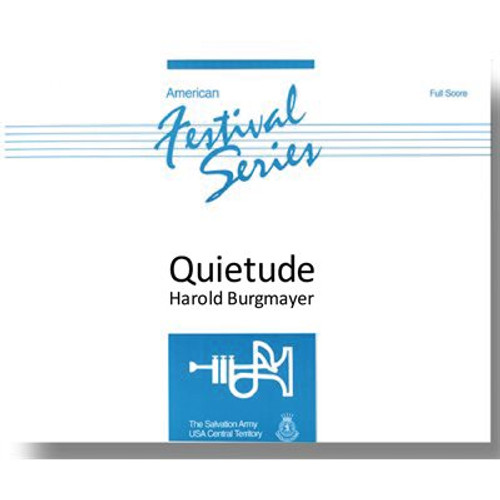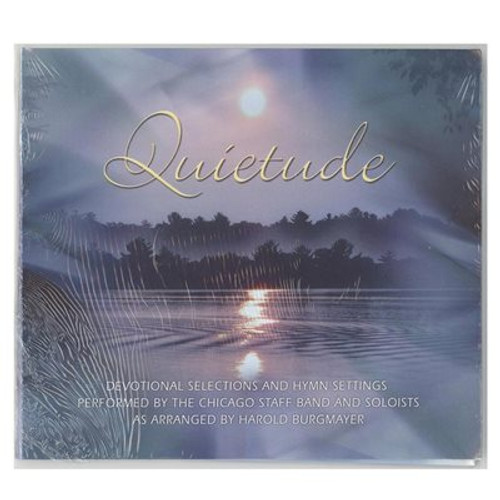Product Description
Quietude
Composer: Harold Burgmayer
Produced by The Salvation Army - Central Territory
Score Sample
NotesThis is a digital product. After purchasing you'll be able to download it from Account -> Orders -> Select order number
Score Notes
Notes:
Program Note:
Quietude is a two-verse setting of the Hubert Parry��s lovely hymn tune Repton. This arrangement was originally conceived for choir. The associated words are from a poem by John Greenleaf Whittier, which appears in many hymnals as verses three and four of the hymn:
Dear Lord and Father of Mankind.
Drop thy still dews of quietness
Till all our strivings cease;
Take from our souls the strain and stress,
And let our ordered lives confess
The beauty of thy peace.
Breathe through the heats of our desires
Thy coolness and thy balm;
Let sense be dumb, let flesh retire;
Speak through the earthquake, wind and fire,
O still small voice of calm!
The world we live in may seem as clamorous as a powerful earthquake, a blustery wind, or a raging fire, but the Lord most often speaks to us in the quietness. It is in the secret place that we find balance: the rhythm of the spiritual life between being and doing, between contemplation and action, between words and silence. May this musical offering serve to call us back to the simplicity and purity of personal worship.
Note to the Conductor:
Beginning to bar 15:
The opening pyramid should be well-blended as the opening chord unfolds ascending from the basses up through the band to the pickup to the hymn melody in the upper cornets. There are ��intended dissonances�� at various places in this piece that will acoustically sound harsh unless deliberately underplayed. One example is in bar 2, on the third beat where there is a half-step dissonance between the 2nd cornet F#/solo horn C# against the solo cornet G pickup to the Repton tune.
Blend and good attention to the melody line and the inner parts of the harmonies are paramount. At bar 7 a small accelerando is called for up to a slightly quicker tempo at bar 9, followed by a slow down to the beginning tempo at bar 11. This opening verse should be played with a rich sonority but never above a mezzo-forte dynamic. The arranger has elected to create a written-out extension of the penultimate phrase as though one were observing a fermata. The last phrase at bar 15 stands in contrast, utilizing a quintet of solo players.
Bars 16-32:
A truncated version of the opening pyramid in basses, baritones and horns sets up the commencement of a second verse in trombone, baritone and euphonium set over a bass pedal. Note the expressive variance of tempo called for before settling into the Fervore tempo at bar 18. Be sure each of the three entrances from the pickup to bar 20 are well-voiced and balanced. The pickup phrases in solo horn and solo cornet at bar 22 begin a written out crescendo (by sequentially adding parts). Like the earlier verse there are expressive fluctuations in tempo called for heading into the full-bodied Risoluto at bar 26. Be sure to not lose the horns moving from bar 27 into bar 28.
Bar 32 to end:
In the original choral version these final bars are sung as an extended Amen, with music based on the opening bars. Once again be gentle with the dissonances, for instance, with the downbeat two bars from the end.
Program Note:
This colorful selection uses three songs of contrasting idiom to portray a progression of the human condition from despair to triumph:
Although this is a more extended work (approximate duration: 9:00), the inclusion of optional introductions and endings provides added usefulness of presenting singular performances of these three songs as follows:
Sometimes I feel like a motherless child: Beginning to optional ending at bars 39-40.
Reach out and touch: Bar 42 to optional ending at bars 110-113.
Storm the forts of darkness: Begin with snare drum roll (can be a pause) one beat before 117. Play to end as written.
Program Note:
This beautiful setting for solo trombones and band of the folk song O Waly, O Waly is often associated with the words of Isaac Watts:Note to the Conductor:
We are pleased to present this sensitive setting as it was initially conceived for solo trombone. Written for the Amsterdam Staff Band's 2005 tour of the United Kingdom, it was later adapted as a feature for trombone ensemble, at the request of Salvationist Publishing & Supplies, where it appears in 2009 as General Series 2059.
We are grateful to SP&S for kindly giving permission to publish this solo version in the American Festival Series. Of this work, the arranger, Olaf Ritman writes: "I consider this song my personal testimony."
Beginning to bar 12: The accompaniment, particularly at the opening and closing of the piece, is atmospheric, with suspended muted chords supporting the rubato trombone solo. The judicious use of percussion (chimes, bass drum and suspended cymbal) will add to the color and mood. Be sure to cue the chimes at bars 3 and 6.
at bar 4, a clear downbeat cure for the bass drum will help clarify tempo following the soloist's pause. Also give attention to the muted sforzando in cornets and trombones in bar 8.
Bars 13-52: Following the ritardando at bar 12, it is essential for the conductor to establish the correct tempo at bar 13, allowing the soloist lyrical freedom and the ability to sustain long phrases as the tune begins at bar 16. The descending scale gesture at bar 39 should be measured, yet not overstated.
Bars 53-74: There is a slight slowing of tempo as soprano, flugel and horns take the theme while cornets, trombones and euphonium adding countermelody.
Bars 75 to end: Returning to the opening tempo, it will again be helpful to give clear cues for the chimes, bass drum and triangle from bars 75 to the end.
[Note: This solo can be heard on the Chicago Staff Band recording,Kurios, performed by Brett Tolcher]
Program Note:
The tune Randolph, by preeminent English composer Ralph Vaughan Williams was first published in 1906 as a setting of Jeremiah Rankin's hymn, of which the first verse reads:
Note to the Conductor:
William Gordon's stunning four verse setting of Randolph progresses from the quiet simplicity of unison cornets and with each succeeding verse builds to a magnificent organ-like finale.
Gratitude is expressed to the publisher and copyright holder, Oxford University Press, for granting permission to publish this brass setting in the American Festival Series.
Beginning to bar 9: A ceremonial snare drum roll is the sole accompaniment to the cornets opening unison rendering of the tune.
Bar 10-17: The mellow instruments (flugel, horns, baritones and euphoniums) provide a beautiful change of color here with 2nd horn, baritones and euphonium seamlessly adding harmony.
Bars 18-26: A two beat snare and bass drum roll signals the entrance of the cornets and trombones in a more brilliant third verse setting. Here the bass trombone is essential (cued in Eb bass). Bring out the rising soprano cornet line from bar 22.
Bar 27 to end: A dramatic percussion roll precedes the "open pipes" organ like sounds of the final verse at bar 27. Be sure to observe the swell in bar 30, followed by a dramatic decrescendo before building to the final climatic chords. Avoid any tendency to overblow while striving for the full sonorities of this majestic finale.
[Note: this setting is especially effective when performed as a benediction "in the round" with players grouped by sections surrounding the audience.]








